
 |
|
|
#1 |
|
All the news that's fit to excerpt
Name: newsie
Location: who knows?
Join Date: Jun 2008 Motorcycle(s): only digital replicas Posts: Too much.
|
[motorcycle.com] - First Look: 2018 Honda Gold Wing and Gold Wing Tour
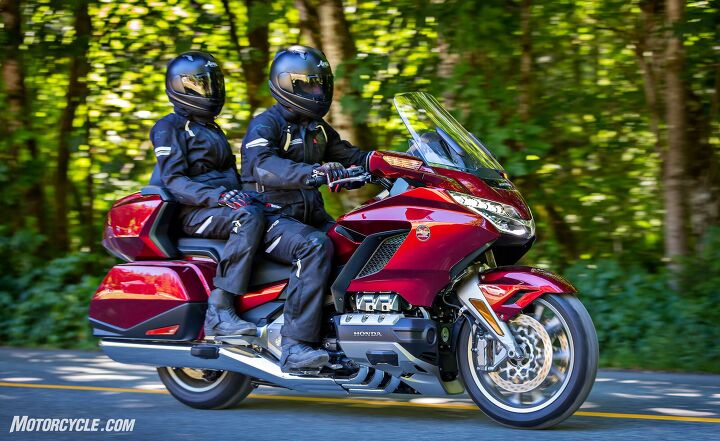 Not many manufacturers can say they’ve had a model in continuous production for 43 years, but Honda can make that claim with their legendary Gold Wing. Over those model years, Honda has set aside just six versions representing what it calls milestone models – the last of which was produced way back in 2001 with the introduction of the GL1800 Gold Wing. The Wing has been well overdue for an upgrade, and the rumor mill was in full-on salivation mode about the prospects of a ground-up remake for 2018. One might imagine how excited we MOrons were at the opportunity to see the new 2018 Gold Wing in the flesh a full day before it would be unveiled to the rest of the world. With that modest head start, we could have a story – and video – ready in time to showcase the new model and its changes the moment our NDA with Honda expired. New 2018 Honda Gold Wing? 2013 Honda Gold Wing F6B Review 2012 Honda Gold Wing Review 2012 Honda Gold Wing Review – First Ride Church Of MO: 2006 Honda Goldwing On Golden Wings Yesterday, we jumped on a 2017 Gold Wing at Honda’s Torrance headquarters and took an afternoon blast up to Santa Barbara for a special meeting with Honda’s development team. To say we were impressed at the first glance of the new bike would be an understatement. The difference in size between the new and old Wings was astonishing. The team at Honda, while maintaining the Gold Wing’s touring roots, clearly has put higher performance front-and-center during the development process. Honda says part of the reason for this is that they want to attract more than just the typical older touring rider. They think the new Wing has the performance chops to entice younger enthusiasts, also. To cement that idea, two variants came out from under their covers at the early unveiling. The standard Gold Wing comes without a trunk, offering more streamlined “bagger” styling. The Gold Wing Tour comes with the more touring-oriented and passenger friendly trunk, it also received some model-specific extras. However, both bikes are based on the exact same platform. 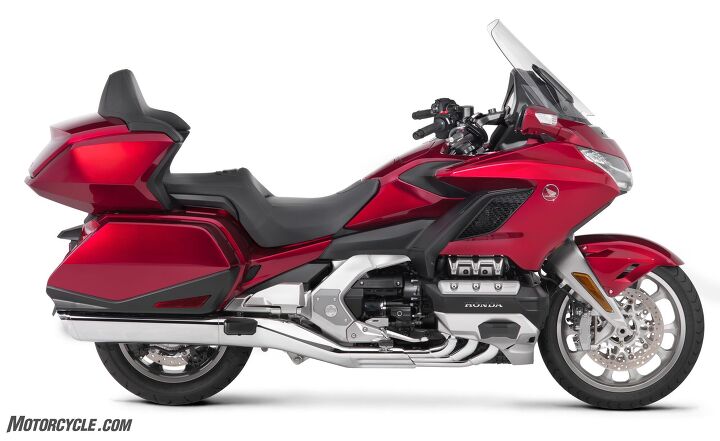 The Gold Wing Tour is what people typically think of when they hear the name, a full-dress tourer complete with trunk. The Gold Wing Tour is what people typically think of when they hear the name, a full-dress tourer complete with trunk.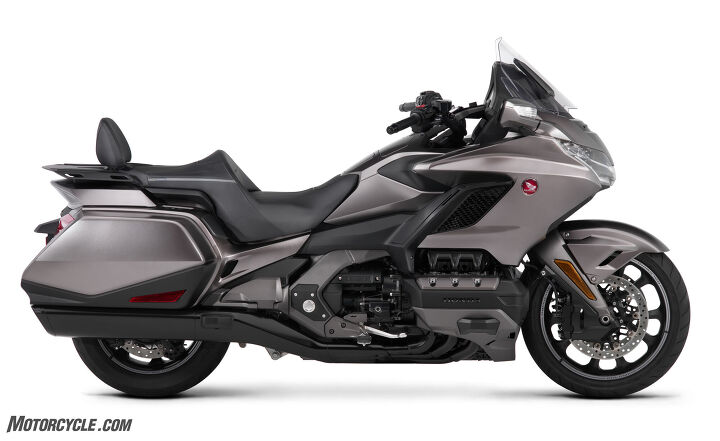 The standard Gold Wing is a little more stirpped down with no trunk. The look is more aggressive thanks to the blacked-out components. The standard Gold Wing is a little more stirpped down with no trunk. The look is more aggressive thanks to the blacked-out components.The changes made to the new Gold Wing focused on three primary areas: Power delivery and efficiency, handling and weight reduction, and technology. Want a hint about how successful the changes were? The 2018 Honda Gold Wing Tour is 90 pounds lighter than the 2017 model. New Engine The 1,833cc SOHC flat-six received a complete makeover for 2018, and when the dust settled, the result was a more powerful engine that is 29mm shorter front-to-back and 13.7 pounds lighter than before (in 6-speed manual configuration). To achieve this shortness, the cylinder bore was dropped 1mm to 73mm (for a perfectly square bore and stroke of 73mm x 73mm), and the distance between bore-centers was shrunk by 9mm to 81mm. Additionally, the cylinder offset from the left and right cylinder banks was reduced by 4mm. Finally, the crankshaft pulser, which is responsible for sensing piston location for the EFI and ignition, was relocated to the rear allowing the engine’s front cover to move 7mm closer to the end of the crank. 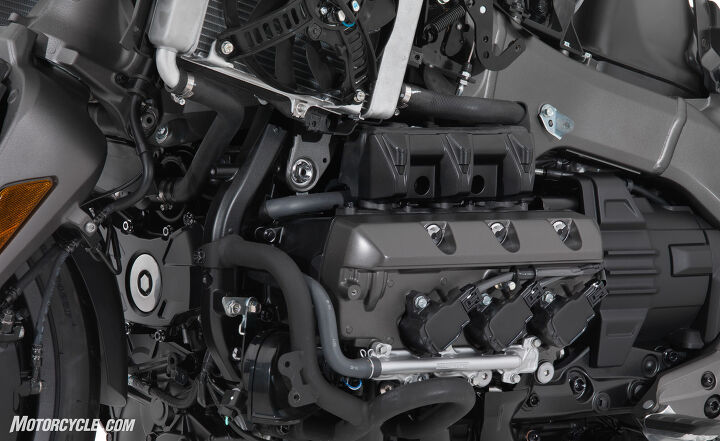 The new engine is 29mm shorter front-to-back which allows it to be moved further forward in the frame. The new engine is 29mm shorter front-to-back which allows it to be moved further forward in the frame.The air/fuel mixture is sucked into the newly aluminum-sleeved, pent-roof-type combustion chambers via new four-valve heads. The old engine only had two valves per cylinder. Controlling the tappets is a Unicam valve train that readers may remember from the CRF450R. By allowing the removal of the valve-lifter-support structure from the previous generation, the finger-follower rocker-arm system on the intake side and roller rocker-arm system on the exhaust side deliver both weight savings and add to the engine’s compactness. 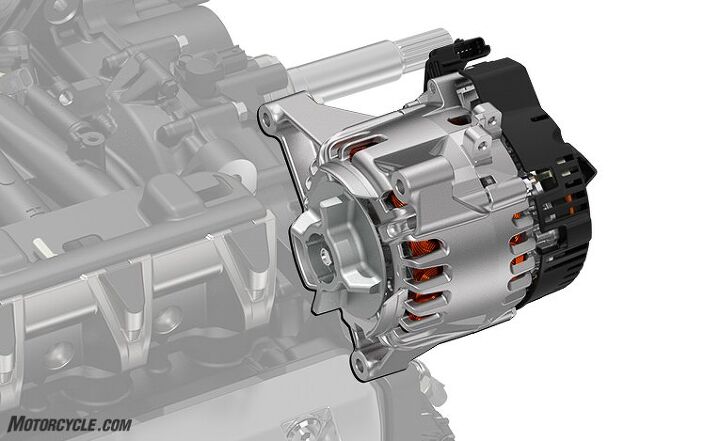 How serious was Honda about compact packaging and saving weight? The Gold Wing’s starter motor and alternator are contained within the same unit, saving 5.3 pounds. How serious was Honda about compact packaging and saving weight? The Gold Wing’s starter motor and alternator are contained within the same unit, saving 5.3 pounds.The intake is lighter and designed swirl the incoming air to assist in better use of the air filter’s entire surface area, while the ducting shape and size have been tuned for improved throttle response and torque delivery at initial throttle openings. Additionally, only one 50mm throttle body is used now, instead of the previous two. On the bottom side of the cylinder heads, the exhaust underwent major changes. While previous Wings had a distinctive style, the 2018 model is a different animal. When the Honda representatives started the engine in the display area, I was surprised by how deep and throaty the exhaust note was. There were still hints of the old sound, but the overall effect of the sound was that of muscularity and bit less of a six-cylinder growl. 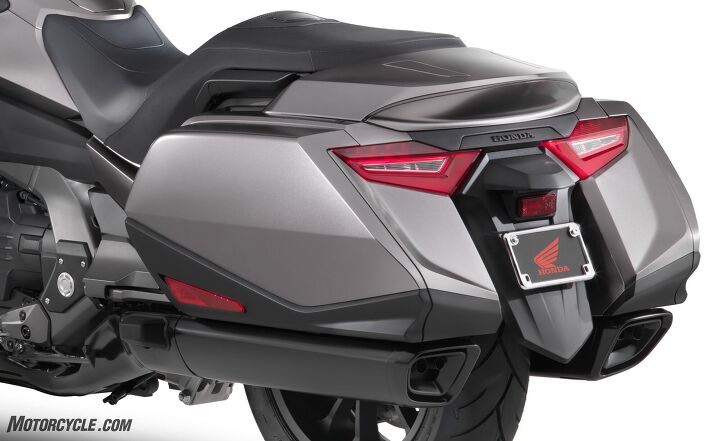 The mufflers are more of a part of the Gold Wing’s style in 2018 – and they sound great, too! The standard Gold Wing gets blacked out components while the Gold Wing Tour gets more chrome. The mufflers are more of a part of the Gold Wing’s style in 2018 – and they sound great, too! The standard Gold Wing gets blacked out components while the Gold Wing Tour gets more chrome.The resulting engine not only sounds different, but* Honda claims it puts out “about 5 more horsepower” than the old Wing. Since Honda doesn’t release horsepower figures, we’ll just have to take their word (and a gander at the graph provided in their press kit). However, that performance increase did not come at the cost of fuel economy. Honda says that the mileage was so improved that, when combined with the Wing’s lessened weight and better aerodynamics, it enabled a 1.1 gallon reduction in fuel capacity (to 5.5 gallons) while maintaining the same touring range of the previous generation. [If you ask MO, we’ll tell you that we’d have been more pleased by an 83 Lb. weight reduction and using that last 7 Lbs to retain that extra gallon of gas…. on a touring bike. -Ed.] 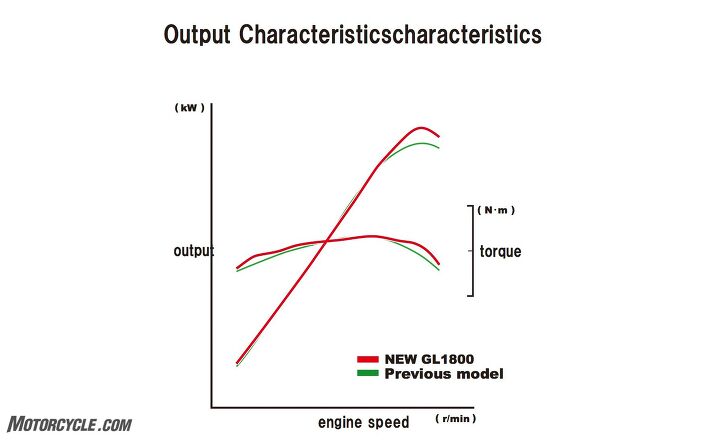 At just about every rpm, the 2018 Gold Wing engine matches or beats the horsepower and torque of the previous model. The improved fuel economy is also a testament to the cleverness of Honda’s engineers. At just about every rpm, the 2018 Gold Wing engine matches or beats the horsepower and torque of the previous model. The improved fuel economy is also a testament to the cleverness of Honda’s engineers.Transmission Options Readers should not be surprised to learn that the 2018 Gold Wing is available with a 7-speed Dual Clutch Transmission (DCT), particularly since the outgoing model was a manual 5-speed. Honda remains firmly committed to dual-clutch technology and claims the implementation in the Wing is their best iteration, yet. In fact, one Honda rep, who is an avid road racer, said that he wouldn’t consider owning the Wing without the DCT – from a performance perspective. However, Honda realizes that not every rider is interested in this technology, so both 2018 Gold Wing models will also be available with a traditional 6-speed manual transmission + reverse mechanism. 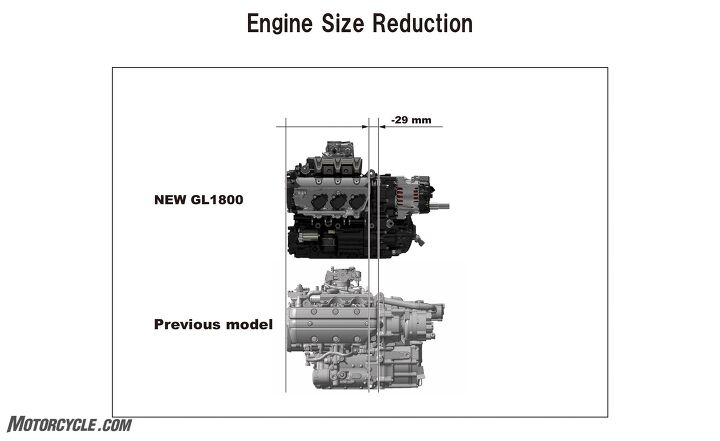 The difference in size between the 2017 and 2018 engines is pretty obvious. The difference in size between the 2017 and 2018 engines is pretty obvious.While both the manual transmission and the DCT version have the same final-drive ratio in top gear, the additional cog in the DCT allows the lower gears to be more tightly-spaced, resulting in less engine-speed drop when changing gears. So, the DCT should actually outperform the standard transmission when running up through the gears – which explains why a road racing test rider could say that he prefers the DCT over the standard transmission on the Wing – not to mention the zero lag time between shifts. One feature of* DCT that Gold Wing riders (particularly those with shorter inseams) will probably be most excited about is the new Walking Mode. Available in both forward and reverse, the Walking Mode utilizes one clutch for forward motion and the other for reverse. On DCT equipped Gold Wings, reverse is now provided by the engine and transmission and not by the starter motor as with the previous model. Walking Mode automatically raises the idle speed slightly and then takes care of the tricky modulation of the clutch engagement. Through the use of the + and – buttons on the left handlebar, Walking Mode delivers a top forward speed of 1.1 mph and 0.75 mph in reverse. 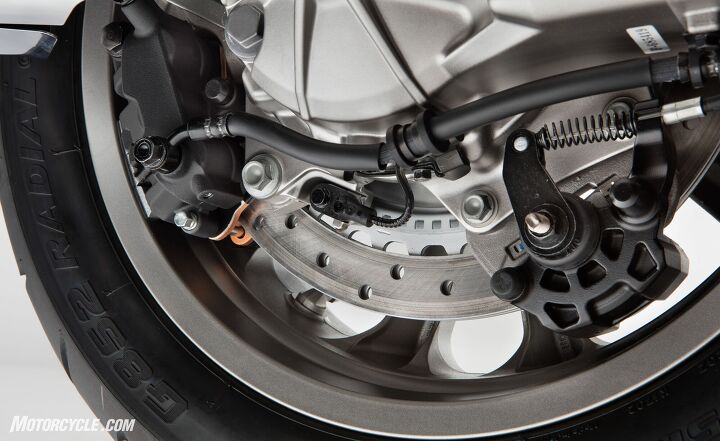 The single piston caliper (right) is the parking brake for the DCT models and is actuated by a lever on the lower left side of the fairing. The single piston caliper (right) is the parking brake for the DCT models and is actuated by a lever on the lower left side of the fairing.Aside from the functional differences between the DCT and the manual transmission, the third generation of Honda’s DCT gained three new rubber dampers to smooth the transmission of power between gears and make shifts even quieter. The 6-speed manual transmission is exactly what one would expect. However, there are two different variations. The base model Gold Wing does not receive a reverse function, and owners will need to back out of parking spaces the old-fashioned way – with their feet. The Gold Wing Tour with the manual transmission has the same electric reverse implementation as used on the previous generation. Ride Modes Since the new engine is controlled by ride-by-wire (RbW), four different ride modes are now available: Tour Mode, Sport Mode, Econ Mode, and Rain Mode. The default Tour Mode provides engine response appropriate for the widest range of riding conditions, balancing power and comfort needs. Sport Mode features more powerful acceleration and snappier throttle response, while on DCT models the rpm are allowed to climb higher. Econ Mode delivers milder acceleration for more relaxed riding in urban/suburban settings with DCT shifting occurring at lower rpm for fuel economy. Rain Mode, not surprisingly, attenuates power in slippery conditions. Ride by wire also enables other technologies for rider comfort and safety. Traction control in the form of Honda Selectable Torque Control mitigates wheel-spin by adjusting the throttle and fuel injection simultaneously. Another boon to riders is the newly implemented Hill Start Assist, which applies rear brake pressure to prevent the bike from rolling backwards after the rider releases the brakes. Although previously available, the Gold Wing’s cruise control has been updated and had some components eliminated that are now better served by the RbW system. New Suspenders! The big news on the Gold Wing’s suspension is the addition of a double-wishbone front end. The shift away from a traditional telescopic fork delivers several advantages. As with all non-telescopic front suspensions, front-end dive is greatly reduced while braking. The second big advantage of those new double-wishbones is better absorption of bumps, thanks to the elimination of the stiction associated with traditional forks. According to Honda, impact shocks delivered from the road to the grips are reduced by 30%. Additionally, Honda claims a 40% reduction in inertial mass in the front end components, which translates into lessened effort for steering inputs. Just sitting on the display bike gives the impression of having the leverage of a much wider handlebar when turning it from lock-to-lock. Unfortunately, we’ll have to wait to see how this feels out on the road, but Honda says the first press rides probably won’t happen until early in 2018. 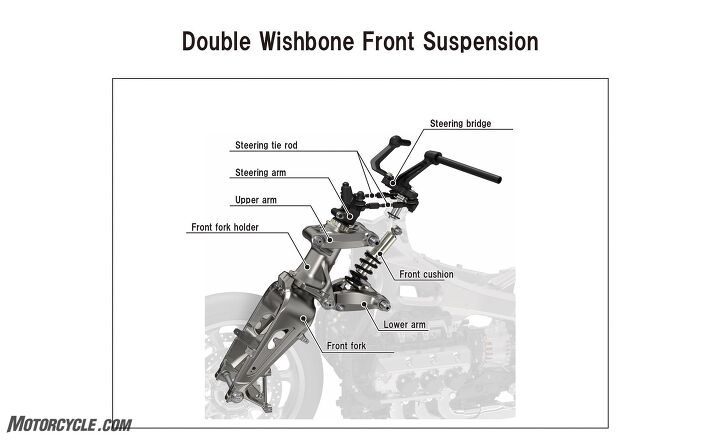 The double-wishbone front suspension is quite different from last year’s telescopic fork – both visually and functionally. The double-wishbone front suspension is quite different from last year’s telescopic fork – both visually and functionally.One unexpected area where the double-wishbone suspension benefits the Gold Wing is in helping to improve the tightness of the vehicle package. With a traditional fork, the wheelbase actually shortens as the sliders compress, requiring* extra space be left between the engine and the front tire. With the new double-wishbone suspension, the wheel tracks straight up and down, meaning the engine can be moved closer to the back of the front tire. On the 2018 Wing, the engine’s new location also allows for the rider to be moved 36mm forward on the chassis. This re-positioning of engine and rider weights pays benefits by increasing forward weight bias for more responsive handling. 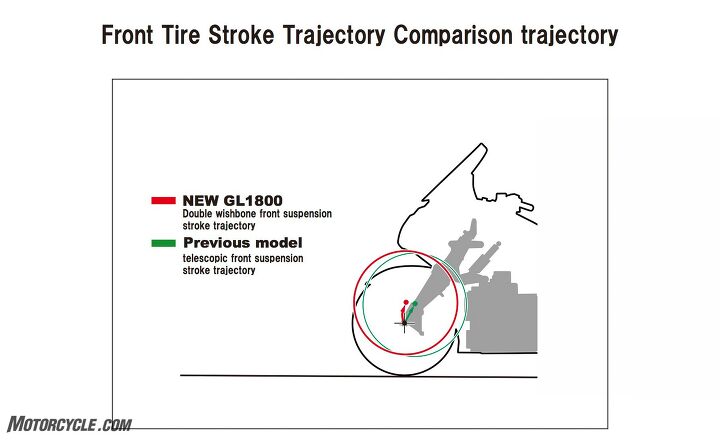 By having the front wheel only moving straight up and down over bumps, the engine can be moved closer to the front tire for improved forward weight bias. By having the front wheel only moving straight up and down over bumps, the engine can be moved closer to the front tire for improved forward weight bias.Out back, a Honda Pro-Link system combines with a Showa shock to control chassis movement. Honda claims that spherical joints at the top and bottom of the shock mitigate the torsion of the Pro-Arm for an improved ride. But wait, there’s more! For 2018, the Gold Wing Tour model gains electrically adjustable preload with four settings: Rider, Rider + Luggage, Rider + Passenger, and Rider + Passenger + Luggage. (Owners of the standard Gold Wing will still have to remove a side panel and twist a remote hydraulic rear preload adjuster.) Additionally on the Tour models, the front and rear damping settings are linked to the ride modes and adjusted automatically to suit. As the ride modes are selected, stepper motors adjust the needles that control oil flow in the front and rear shock valves, allowing for a firmer or a more plush ride. 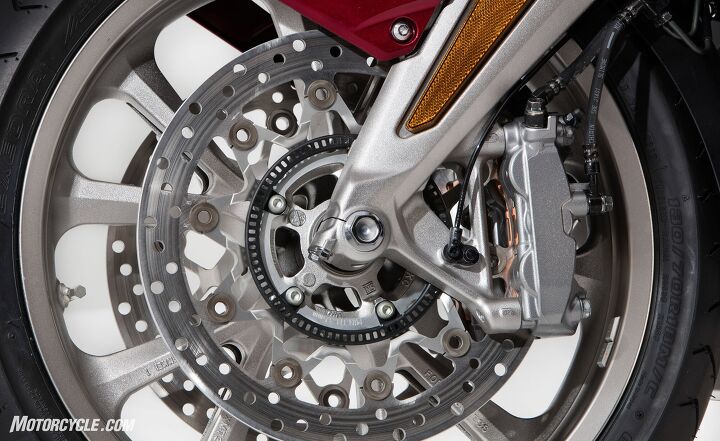 Honda’s combined ABS slows the front end with a pair of six-piston radially-mounted calipers squeezing 320mm rotors. Honda’s combined ABS slows the front end with a pair of six-piston radially-mounted calipers squeezing 320mm rotors.Beefier Brakes When it comes time to slow the beast, riders will have a pair of six-piston radially-mounted calipers squeezing 320mm front rotors at their disposal. How big is the change from last year? Three pistons in conventionally-mounted calipers had only 296mm discs to embrace. The combined (linked) ABS system has been updated to better balance the braking forces applied to the front and rear wheels. In the process, the two-motor system was converted to just a single, smaller, lighter ABS modulator integrated with the brake system’s ECU. Additionally, the ABS settings are linked with the ride modes to have the brake system’s characteristics in line with those of the engine and suspension settings. 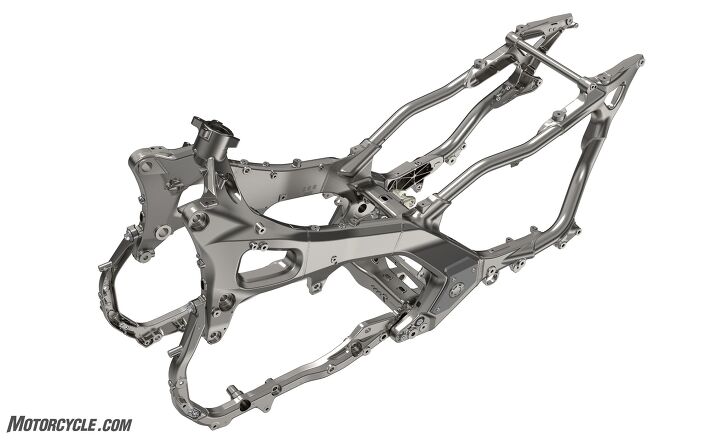 The visible portions of the frame may look the same as last year’s model, but it’s a completely new unit. The visible portions of the frame may look the same as last year’s model, but it’s a completely new unit.Chassis Changes – An All New Frame Don’t be fooled by the similar look of the the 2018 Gold Wing’s new twin-spar frame. Changing the front suspension and moving the engine forward required a complete redesign. Through the use of different plate thicknesses in various areas of the frame, Honda’s engineers were able to tune different sections of the chassis for specific stiffness and flex characteristics to best suit the rest of the new hardware. All of this was in an effort to achieve a balance of stability and maneuverability. The end result is a more mass-centralized frame that weighs-in 4.4 pounds lighter than its predecessor. The Gold Wing’s swingarm also received updates. The single-sided unit with internal shaft drive plays a significant role in the chassis’ overall rigidity balance and contributes to the Wing’s improved ride. Wrapped in a Stunning Package Up until now, we’ve only been considering the technology and function of the 2018 Gold Wing. The new design also plays an important role in the overall character of the motorcycle. In the case of the new Gold Wing, that personality is a little surprising for a 43 year old touring motorcycle. The Gold Wing’s visage is narrower and more muscular than the previous generation’s. While keeping the same side-mount radiator system, the engineers were able to narrow the front fairing by about 7.9 inches! In the process, the 2018’s aerodynamic drag has dropped by an impressive 11.8%. 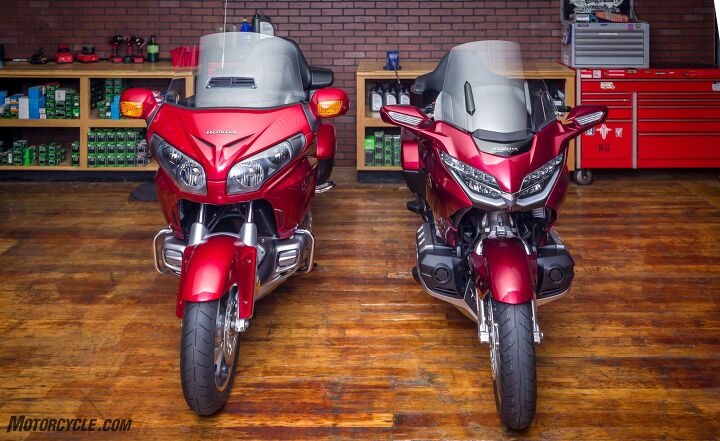 This side-by-side image makes the previous generation Gold Wing (left) look positively porky next to its more chiseled and buff younger sibling. This side-by-side image makes the previous generation Gold Wing (left) look positively porky next to its more chiseled and buff younger sibling.Honda’s reps stressed that, thanks to improved airflow management, the rider and passenger enjoy a completely new riding experience on the 2018 Gold Wing. Rather than trying to place the occupants inside a completely windless bubble, the designers worked to have the wind flow smoothly over them. Consequently, new air ducts flow more air into the cockpit. A new, electrically-controlled windshield allows the rider to better control the airflow. Previously, the rider had to stop and manually lift/lower the windscreen to account for changing weather conditions. Now, the height can be adjusted on-the-fly as the rider moves from suburban streets to open highways. A cool feature of the windshield is that when the bike is powered off, the screen moves to its lowest position to facilitate easier mounting of a bike cover. As soon as the Wing is powered on, the windshield returns to its previous location. Earlier we noted that the more forward riding position helped with the bike’s weight bias. Well, the closer rider location means that the windshield can be smaller than last year’s while still providing better protection. Finally, one difference between the two Gold Wing models is that standard versions receive a shorter, but still adjustable, windscreen. 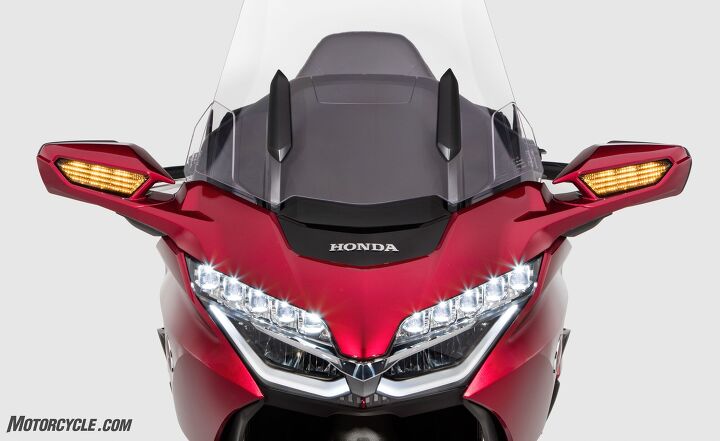 For 2018, all Gold Wing lighting is now from LEDs. Look to the mirror mounts and the lower edge of the windscreen to see the new airflow ducts. For 2018, all Gold Wing lighting is now from LEDs. Look to the mirror mounts and the lower edge of the windscreen to see the new airflow ducts.Convenience Technology Touring bikes are created for gobbling up massive amounts of asphalt while keeping the rider and passenger comfortable and entertained. Also, with the Gold Wing being Honda’s flagship motorcycle, it has always been given the privilege of showcasing the best that the company has to offer. So, MO had high hopes as to what was in store for the next Wing. We’ve already covered niceties like the electronically adjustable windscreen and suspension plus the Hill Start Assist. But those are features that have been around on other brand’s bikes for a long time, thankfully there’s more. The instrument cluster has grown to be even more of a “dash” that it was before. Front-and-center is the exceptional 7-inch TFT display screen which houses the menus for the rider aids and audio system. Most importantly, the TFT is home base for the navigation system – which is important for far-flung journeys. The Gold Wing’s GPS is standard equipment for all versions. The big surprise about the GPS is that it comes with 10 years of free updates from Honda, and that’s bound to make long-term owners happy! Another key feature to the new TFT is Apple CarPlay integration which will give riders access to their favorite entertainment and navigation apps. Users with Bluetooth headsets will also have Siri integration and the ability to play audio directly through their helmet speakers instead of always through the Wing’s onboard speakers. Android users shouldn’t worry, though. Honda is working to integrate Android Auto into a future firmware upgrade. 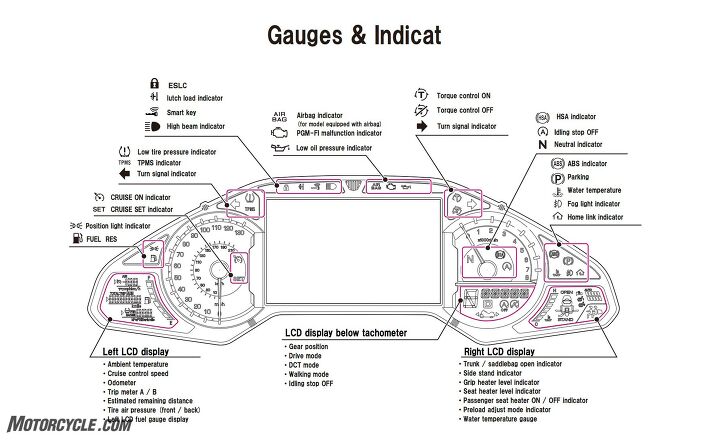 If the 7-inch TFT display isn’t enough for you, the rest of the 2018 Gold Wing’s dash is jam-packed with information. If the 7-inch TFT display isn’t enough for you, the rest of the 2018 Gold Wing’s dash is jam-packed with information.As is becoming more common in luxury model motorcycles, the Gold Wing features a keyless ignition. In fact, there is no slot for an ignition key on the bike – just a knob atop the center console. The saddlebags and trunk locks are also controlled by the key fob, and they open electronically with the push of a soft-touch button. If you don’t have your fob with you, the bags will not let you close them. They’ll just pop back open. Similarly, you can’t lock the fob inside one of the bags. One cool feature of the key fob is its on/off switch which disables the wireless function. This nice touch will keep strangers from being able to open your bags or start the engine if your fob is in range. While this is an esoteric touch, it shows the level of thought that Honda has put into the Gold Wing’s makeover. 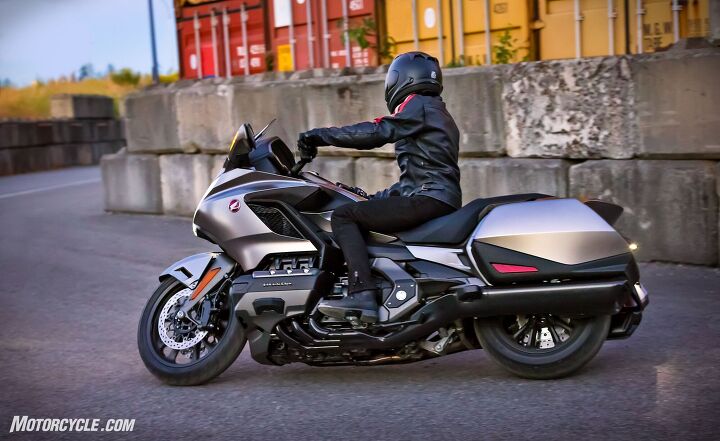 It’s All Over but the Waiting In this sneak peak that Honda gave MO on the Monday before the 2018 Gold Wing’s unveiling to the public, we’ve been impressed with just how much has changed on this storied motorcycle. These changes add up to a more powerful machine that is 90 pounds lighter than its predecessor. It also gets better fuel economy – to the tune of Honda claiming it’s able to travel the same distance on a tank that is now one gallon smaller. Riders get the choice of a traditional manual 6-speed or a 7-speed DCT. The addition of Ride by wire brings with it a number of nice changes from ride modes to electronically adjustable suspension settings that are linked to those mode. Honda says the new double-wishbone front suspension represents a huge change in both ride comfort and performance. Finally, the rider and passenger accommodations promise better airflow management in addition to new entertainment and communication options. Then there’s the fact that Honda has built two Gold Wing models, one with a trunk and one without. For base Gold Wing buyers who decide later that they want the trunk, accessory add/remove trunk kits will be available from Honda. That way, riders who want the more advanced suspension of the Gold Wing Tour can have the trunkless “bagger” style back end of the base model, if they like. The standard Gold Wing’s MSRP begins at $23,500, and the Gold Wing Tour ranges from $26,700 to $31,500. Now comes the bad news for riders who are as excited to throw a leg over the 2018 Honda Gold Wing as we are. The bikes won’t be in dealerships until February of 2018. While that’s not a terribly long time to wait, you won’t get to hear the beefy exhaust note from its shapely mufflers. The sound of the flat-six is, as it has always been, intoxicating. 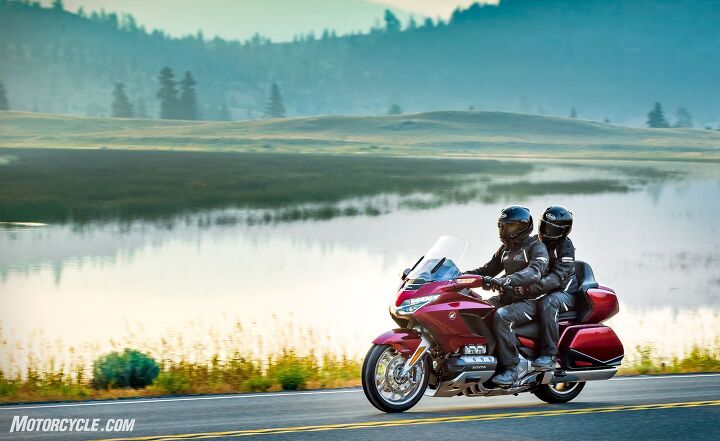 2018 Honda Gold Wing SpecificationsHonda Gold WingHonda Gold Wing TourMSRP$23,500 – $23,800 (6-speed) $24,700 – $25,000 (DCT)$26,700 – $27,200 (6-speed) $27,700 – $28,200 (DCT) $31,500 (DCT & Airbag)Engine Type1,833cc horizontally opposed six-cylinderBore and Stroke73mm x 73mmFuel SystemEFI, 50mm throttle bodyCompression Ratio10.5:1Valve TrainSingle overhead Unicam® w/ 4 valves per cylinder, finger-follower rocker arm on intake, roller-rocker arm on exhaustTransmission6-speed manual or 7-speed automatic DCT w/ Walking Mode F/R6-speed manual w/ Reverse or 7-speed automatic DCT w/ Walking Mode F/RFinal DriveShaftFront SuspensionDouble-wishbone front-suspension system w/ Showa shock absorber, 4.3 in. travelRear SuspensionPro-Link® system w/ Showa shock absorber, 4.1 in. travelFront BrakeTwo radially mounted 6-piston Nissin calipers w/ 320mm rotors, electronically controlled combined ABSRear Brake3-piston Nissin caliper w/ 316mm rotor, electronically controlled combined ABSFront Tire130/70-18Rear Tire200/55-R16Rake/Trail30.5° / 4.3 in.Wheelbase66.7 inSeat Height29.3 in.Curb Weight787 lbs. 800 lbs. (DCT)833 lbs. (6-speed & DCT) 842 lbs. (Air Bag DCT)Fuel Capacity5.5 gal.Available ColorsCandy Ardent Red, Matte Majestic Silver, Pearl Stallion BrownCandy Ardent Red, Pearl White, Pearl Hawkseye Blue 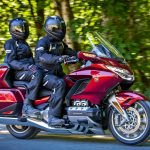  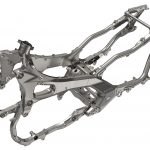 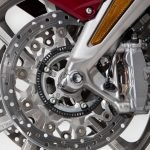 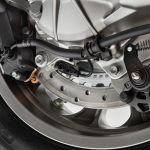 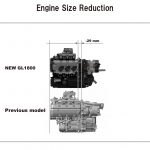 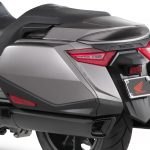 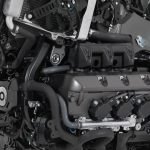 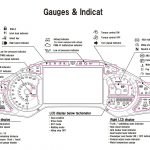 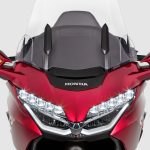 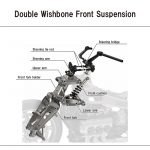 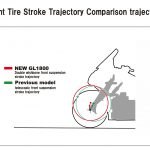 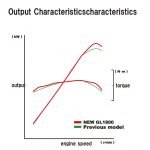 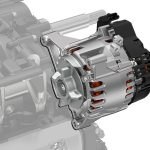 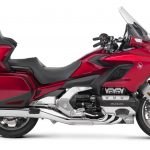 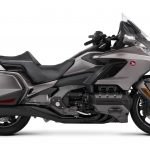 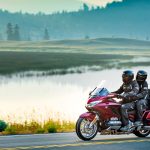 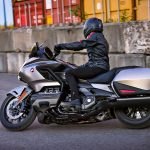 First Look: 2018 Honda Gold Wing and Gold Wing Tour appeared first on Motorcycle.com. First Look: 2018 Honda Gold Wing and Gold Wing Tour appeared first on Motorcycle.com.Click here for full story...
__________________________________________________
I'm a bot. I don't need no stinkin' signature... |
|
|

|
 |
 Similar Threads
Similar Threads
|
||||
| Thread | Thread Starter | Forum | Replies | Last Post |
| [RoadRUNNER] - 2018 Honda Gold Wing & Gold Wing Tour | Ninjette Newsbot | Motorcycling News | 0 | October 24th, 2017 07:30 PM |
| [motorcycle.com] - New 2018 Honda Gold Wing? | Ninjette Newsbot | Motorcycling News | 0 | September 22nd, 2017 11:21 AM |
| [motorcycle.com] - HeliBars Offering $100 On-Site Gold Wing/F6B Installation At Wing | Ninjette Newsbot | Motorcycling News | 0 | August 19th, 2015 03:41 PM |
| [motorcycle.com] - 2015 Honda Gold Wing and Gold Wing F6B Mark 40th Anniversary | Ninjette Newsbot | Motorcycling News | 0 | September 4th, 2014 10:00 AM |
| [RoadRUNNER] - 2014 Gold Wing Road Rider’s Association Annual Wing Ding | Ninjette Newsbot | Motorcycling News | 0 | May 5th, 2014 05:10 AM |
| Thread Tools | |
|
|